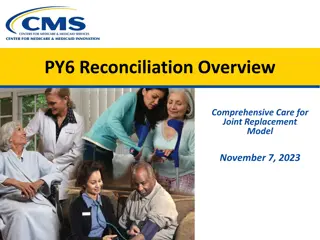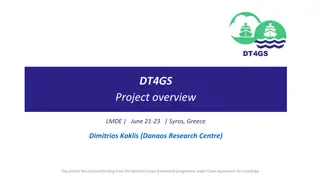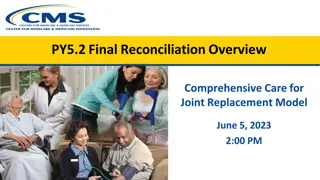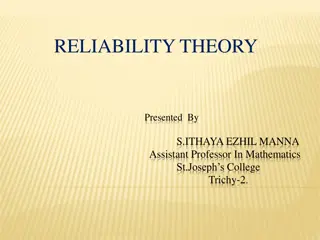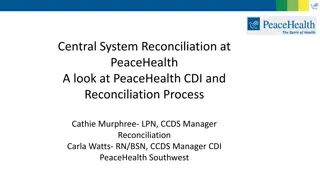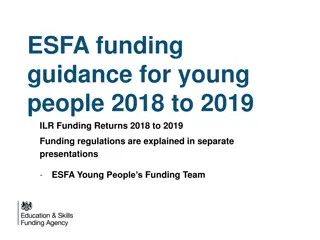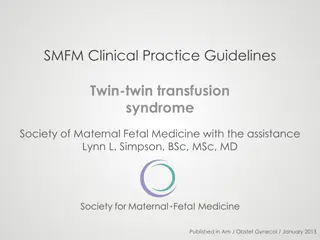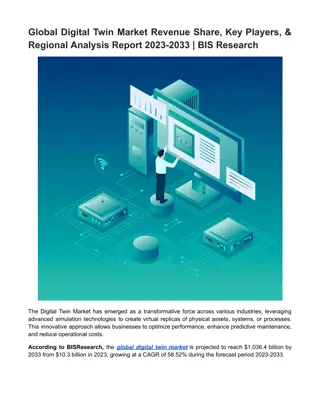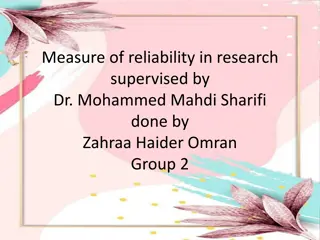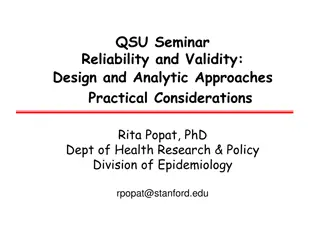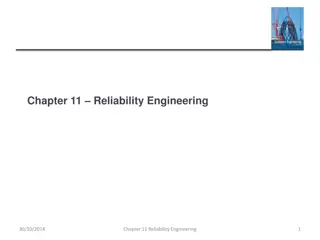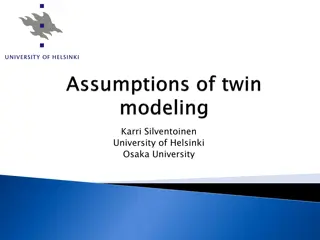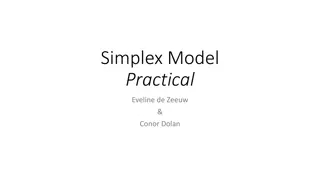Improving Measurement Reliability with Data Reconciliation and Digital Twin
Collecting accurate measurement data is crucial for various operations. This work focuses on enhancing measurement reliability through data reconciliation and digital twin technology, emphasizing the reduction of errors and the improvement of precision. The study discusses methodologies, case studies, results, and conclusions related to data reconciliation and gross error detection, utilizing a probabilistic safety assessment and management approach. Additionally, the importance of an accurate physical model for reliable reconciled values is highlighted. The limitations and advancements in the field, along with relevant studies and commercial software, are also discussed.
Uploaded on Mar 12, 2025 | 3 Views
Download Presentation

Please find below an Image/Link to download the presentation.
The content on the website is provided AS IS for your information and personal use only. It may not be sold, licensed, or shared on other websites without obtaining consent from the author.If you encounter any issues during the download, it is possible that the publisher has removed the file from their server.
You are allowed to download the files provided on this website for personal or commercial use, subject to the condition that they are used lawfully. All files are the property of their respective owners.
The content on the website is provided AS IS for your information and personal use only. It may not be sold, licensed, or shared on other websites without obtaining consent from the author.
E N D
Presentation Transcript
PSAM 16 Improving Measurement Reliability using Data Reconciliation and Digital Twin Probabilistic Safety Assessment and Management 16 2022.06.30. Kyusik Oh, Department of Nuclear Engineering, Kyung Hee University Sangjun Park, iSMR System Development Division, Korea Atomic Energy Research Institute Gyunyoung Heo, Department of Nuclear Engineering, Kyung Hee University
This work was supported by the National Research Foundation of Korea(NRF) grant funded by the Korean government(MSIP:Ministry of Science, ICT and Future Planning) (No. 2017M2B2B1072806). 2
CONTENTS CONTENTS 1. Introduction 1) Background 2) Objective 2. Methodology 1) Data Reconciliation 2) Gross Error Detection 3) Code Algorithm 3. Case Study 4. Result 5. Conclusion 6. Appendix 3
BACKGROUND BACKGROUND Collecting accurate measurement data is important for operation, monitoring instruments, calculation of power or efficiency, etc. Errors in the data should be reduced or eliminated Random Error - Neither the magnitude nor the sign of the error - Different values under same condition - Probability distribution e.g. power fluctuation, network transmission, background noise, etc. Fig. 1. Random Error - - - e.g. miscalibration, corrosion, solid deposit, etc. A certain magnitude and sign which may be unknown Same contribution under same condition Bias Gross Error Fig. 2. Gross Error 4
BACKGROUND BACKGROUND Data Reconciliation(DR) True values are estimated using physical model constraints. Data are corrected differentially for their own accuracy. Random error is reduced and precise is increased. Gross Error Detection(GED) Variables with suspected gross errors are identified. The accuracy of the results of DR is improved. It is an indicator for updating the physical model. ? is Measured Value ? is Estimated True Value from Model ? is Covariance of Measurement. Data Reconciliation Least squared Function Minimize the Random Errors ??? ?, ? = ? ??? ? ? Measured Value Detect the Gross Error Estimate the Unmeasured Value ? ?, ? = ? ? ?, ? > ? Principle Principle 5
BACKGROUND Limitation However, with digital twin, the accuracy of model has increased. Reconciled values cannot be reliable unless the physical model is accurate. Studies and Commercial Software Alireza Behroozsarand, Shabnam Afshari, Data Reconciliation of an Industrial Petrochemical Plant Case Study: Olefin Plant (Hot Section), Computers and Chemical Engineering, Vol. 137, No. 106803, June 2020. Maur cio M. C mara et al., Numerical Aspects of Data Reconciliation in Industrial Applications, MDPI, Vol. 5, No. 4, October 2017. Eduardo Damianik Valdetaro, Roberto Schirru, Simultaneous Model Selection, Robust Data Reconciliation and Outlier Detection with Swarm Intelligence in a Thermal Reactor Power Calculation, Annals of Nuclear Energy, Vol. 38, No. 9, pp. 1820-1832, September 2011. Verein Deutscher Ingenieure, Control and quality improvement of process data and their uncertainties by means of correction calculation for operation and acceptance tests, 2018. RECON, BTB JANSKY, OpenRefine, TIBCO Clarity, Winpure It seems rare that the method of updating the physical model and the strategy of maintaining the actual measurement system are explained together. No General Software with Opened Source Code, also Not in South Korea 6
OBJECTIVE OBJECTIVE In-house Code is Developed and Validated Reactor Temperature Reconciliation - Kyusik Oh, Sangjun Park, Gyunyoung Heo, Application of Reactor PHM using Data Reconciliation Algorithm, Korean Society for Prognostic and Health Management, 2021. Uranium Materials(235U, 238U) Reconciliation - Kyusik Oh, Sangjun Park, SeungMin Woo, Gyunyoung Heo, Application of Data Reconciliation Algorithms to Improve Nuclear Process Monitoring, International Symposium on Future I&C for Nuclear Power Plants, 2021. Objective To introduce a strategy to update the physical model using code, taking the heat exchanger system 7
DATA RECONCILIATION DATA RECONCILIATION If the constraint equation ? is nonlinear, it is linearized with the Taylor series Formulation of Data Reconciliation Least Squares Method ? ?, ? = ?? ? + ?? ? ? ? = ??? + ??? ?(?,?) (?? ??)2 ?? ? ??? 1(? ?) ?? ? ???= ?? ? ?are Jacobian matrices containing partial min ?, ? = min ?, ? where ??= derivatives of the constraint equations ? for ? and ?, respectively. 2 ? Subject to ? ?, ? = ? ??must be removed for reconciliation. It can be removed through the QR decomposition. ? is an m 1 vector of raw measurements for M process variables ? is an m 1 vector of estimates (reconciled values) for the M process variables ? is an n 1 vector of estimates for unmeasured process variables, ? ? is an m m covariance matrix of the measurements ? is a c 1 vector describing the functional form of model equality constraints. ?1 0 ?2 0 ??= ?? = ?1 ?2 ?T? = ? ? ?, ? = ? ?2 ??? ? + ?2 ??? ? ?2 ?? = ? ??? ? ? = ? ?2 Solution of DR Problem Lagrange Multipliers ? is a m m orthogonal matrix ?1is the first p basis vector for matrix ? ?2is the second m p basis vector for matrix ? ?1is a nonsingular p p upper triangular matrix ? ?, ?,? = ? ??? 1? ? 2???( ?, ?) 8
DATA RECONCILIATION Premultiplying by matrix ?? ? ?? ?? ? ??? ??? ?? ?? ?1 ?2 ?1 ? ?2 ? ?1 ?2 = ? is the rank of ?? ? is total number of unmeasured values ??is estimates of unmeasured points that can be estimated (observable) ?? ? is estimates of unmeasured points that cannot be estimated (unobservable) New Estimates for ? and ? ? ? ? ??? ???? ?? ??? ?(??? ?) ? = ? ? ?? ?? ?? 1?1 ?? ?? ? ?1 1?2 ?? ? 1?2= ? ??= ?1 ??can be estimated when ?1 If ? is nonlinear, the solution process is repeated until | ?? ?? 1 | < ? ?? 9
GROSS ERROR DETECTION GROSS ERROR DETECTION Where Gross Error is - Serial Elimination Method for GED - Global Test ??= ?? ?? ? = ? + ? g : number of measurements without suspected gross errors c : number of measurements assumed to have gross errors ? ? = ?, ??? ? = ? ?? 0 0 ??= ??+ ? ?(?? ? ?) ? = ?2 ? : the increase due to gross error ?(??? ?) ? = ?2 ??= ??????? = ???????+ ????+ ? ??? = ? + ?? ? ??? ? ???? ?2 ??? ? = ???(?) = ?2 ? = ??? 1? 1= ? 1{? ?? ? 1+ ?? ?? 1?? ?? 1?? ?? 1} 1?? ?? 1} ?? = ? 1{? ???? 2 ? ?1 ? m : degrees of freedom (rank of ?2 ? 1?? ???) ? = ???? 1? There is a (1 ? )*100 % chance that the data set contains gross errors in one or more of the measurements. 2 ?i< ?1 ? ?? may contain gross error ? 10
CODE ALGORITHM CODE ALGORITHM The sequence of DR and GED Process Models Yes 2 Material Balance 3 Energy Balancee Reconciled Data Gross Error 1 measurements Data Reconciliation Variance of Reconciled Data No 4 Dynamic Steady-State Estimates of unmeasured points Corrected & Estimated values All measured Not all measured All measured Not all measured 1. Reduce Random Errors in Measurements through data Reconciliation 2. Correct Measurements and Calculate Estimates of Unmeasured Points 3. Detect and Identify Variable Suspected to Have a Gross Error in Reconciled Data 4. Output Corrected Values and Estimates of Unmeasured Points where Gross error is Eliminated. 11
CASE STUDY Problem Description E1, E2 : heat exchanger C : mixer D : splitter ??= 2.2 kJ?? 1? 1 12
CASE STUDY Constraints m1 m2= 0 m8 m11= 0 m1cp T1+ m8cp T8 m2cp T2 m11cp T11= 0 m2 m3 m4= 0 T3 T2= 0 T4 T2= 0 m4 m6= 0 m9 m10= 0 m4cp T4+ m9cp T9 m5cp T5 m10cp T10= 0 m3+ m5 m6= 0 m3cp T3+ m5cp T5 m6cp T6= 0 m6 m7 m8= 0 m6cp T6 m7cp T7 m8cp T8+ Q Q = 0 Mass balance E1 Enthalpy balance Mass balance S Enthalpy balance Mass balance E2 Enthalpy balance Mass balance C Enthalpy balance Mass balance D Enthalpy balance 13
CASE STUDY Measured and Estimates of Unmeasured Values are substituted for vector ? Constraints m1 m2= 0 y[1] ?[2] = 0 m8 m11= 0 y[17] ?[4] = 0 Variables in code Variables in code Values Values m1cp T1+ m8cp T8 m2cp T2 m11cp T11= 0 y 1 cp? 5 + ? 17 cp? 8 ? 12 cp? 19 ? 4 cp?[11] = 0 y[1] y[12] m1 m2 m2 m3 m4= 0 y[12] ?[13] ?[14] = 0 y[2] y[13] m7 m3 y[3] y[14] m9 m4 T3 T2= 0 y[20] ?[19] = 0 y[4] y[15] m11 m5 T4 T2= 0 y[21] ?[19] = 0 y[5] y[16] T1 m6 m4 m6= 0 y[14] ?[15] = 0 y[6] y[17] T6 m8 y[7] y[18] T7 m10 m9 m10= 0 y[3] ?[8] = 0 y[8] y[19] T8 T2 m4cp T4+ m9cp T9 m5cp T5 m10cp T10= 0 ? 14 cp? 21 + ? 3 cp? 9 ? 15 cp? 22 ? 18 cp?[10] = 0 y[9] y[20] T9 T3 m3+ m5 m6= 0 y[13] + ?[15] ?[16] = 0 y[10] y[21] T10 T4 y[11] y[22] T11 T5 m3cp T3+ m5cp T5 m6cp T6= 0 y 13 cp? 20 + ? 5 cp? 22 ? 16 cp?[6] = 0 y[23] Q m6 m7 m8= 0 y[16] ?[2] ?[17] = 0 y[24] Q m6cp T6 m7cp T7 m8cp T8+ Q Q = 0 ? 16 cp? 6 ? 2 cp? 7 ? 17 cp?[8] + ?[23] ?[24] = 0 14
Measurement s Reconciled Values Corrected Variance Variables Variance 1.01 (t/h) 0.01 (t/h) 1.0068 (t/h) 0.0056 (t/h) m1 RESULT - - 1.0068 (t/h) m2 - - - m3 - - - m4 - - - m5 The raw measurements do not satisfy the flow balance and heat balance, but the reconciled estimates satisfy. - - 1.0068 (t/h) m6 0.32 (t/h) 0.01 (t/h) 0.3236 (t/h) 0.0056 (t/h) m7 - - 0.6832 (t/h) m8 0.79 (t/h) 0.01 (t/h) 0.7898 (t/h) 0.0056 (t/h) m9 - - 0.7898 (t/h) m10 0.68 (t/h) 0.01 (t/h) 0.6832 (t/h) 0.0056 (t/h) m11 ? = 19.87 21 (K) 0.5 (K) 20.99 (K) 0.273 (K) T1 2 ?0.95 13 = 22.36 - - 74.92 (K) T2 - - 74.92 (K) T3 Test statistic is lower than critical value, Therefore there are no gross error in the system. It can be concluded that there is no problem with the process model. - - 74.92 (K) T4 - - - T5 100 (K) 0.5 (k) 100.01 (K) 0.273 (K) T6 81 (K) 0.5 (K) 81 (K) 0.273 (K) T7 119 (K) 0.5 (k) 118.99 (K) 0.273 (K) T8 137 (K) 0.5 (K) 136.99 (K) 0.273 (K) T9 105 (K) 0.5 (k) 105.01 (K) 0.273 (K) T10 39.5 (K) 0.5 (K) 39.51 (K) 0.273 (K) T11 - - - Q 15 - - - Q
CONCLUSION CONCLUSION This study is try to improve the reliability of the data using in-house DR and GED algorithm code. According to result, Corrected data improved accuracy by satisfying the constraints. Precision also improved by reducing the variance of the corrected data. By confirming that there is no gross error, the model of the process is reliable. If there is a system error, it can be instructed to identify defects in the instrument or system at the location where the system error is found. 16
Thank You Kyusik Oh, ohsik95@gmail.com Sangjun Park, sangjun@kaeri.re.kr Gyunyoung Heo, gheo@khu.ac.kr


